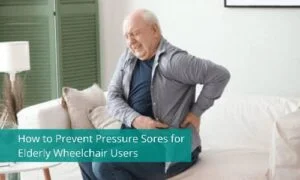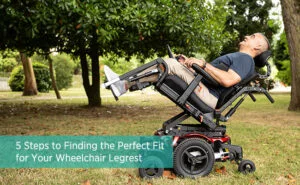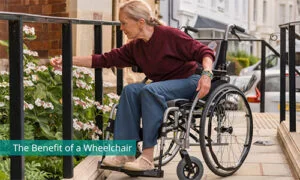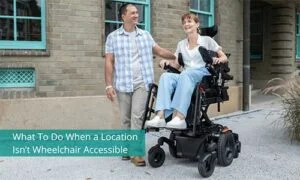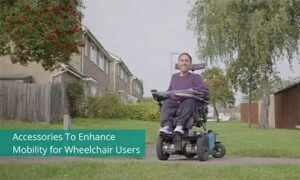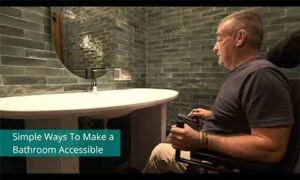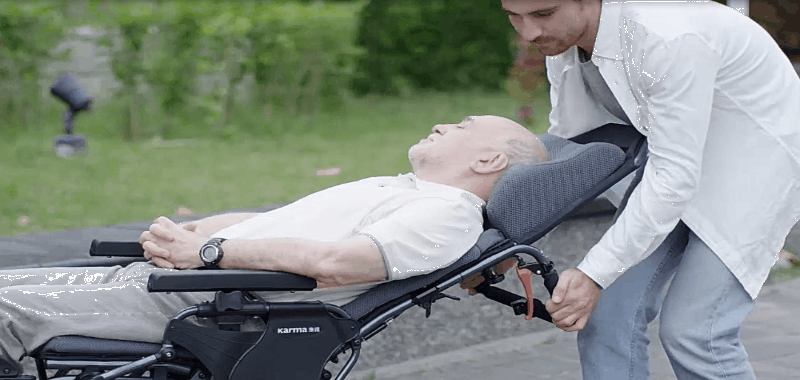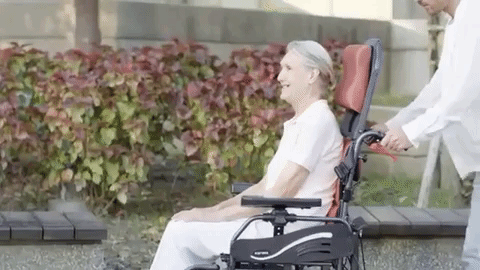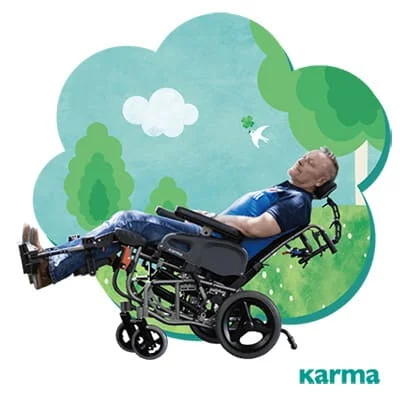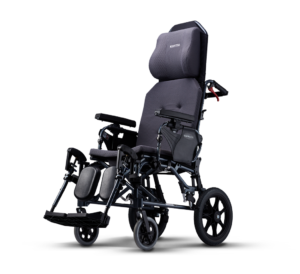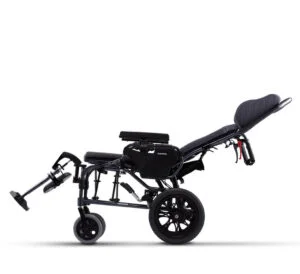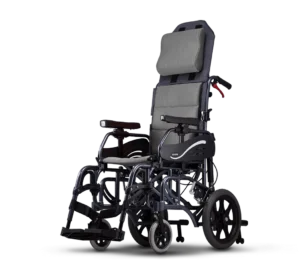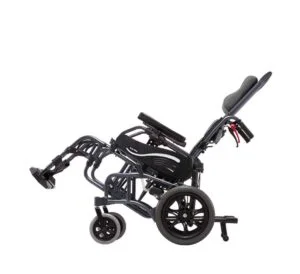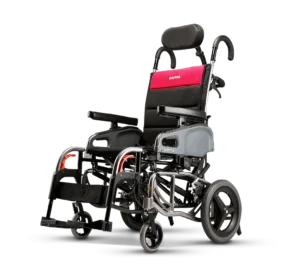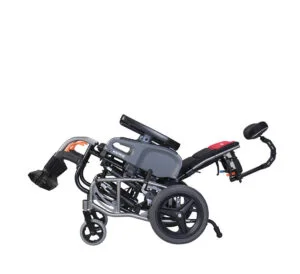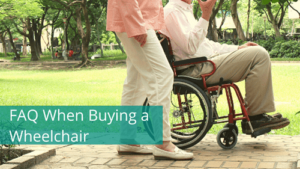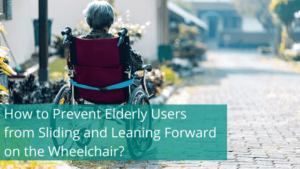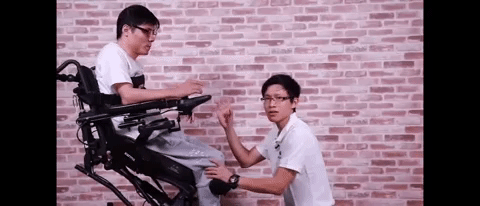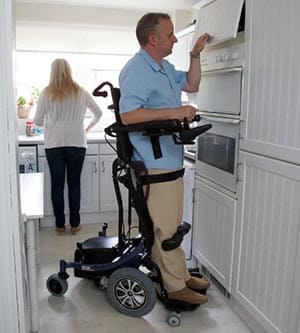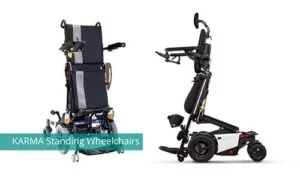Wheelchair seat cushions
Over time, the upholstery of the wheelchair can start to stretch, resulting in the hammock effect. The solution to this is to put a hard board/surface on the wheelchair seat with a wheelchair cushion. There are different types of seat cushions to choose from depending on the users budget and sitting requirements.
 |
 |
 |
|
| Wheelchair Cushion Form | Liquid Gel | Interconnected Air Cells | Vicair Air Cushion |
| Ability to Redistribute Pressure | Medium | High | High |
| Stability | Highest | Medium | High |
| Adjustability | Low | High | High |
| Weight | Heavy | Medium | Light |
| Breathability | Low | Medium | High |
| Maintainability | Does not require much maintenance | Needs regular inflation maintenance | Does not require much maintenance |
| Risk of Deflation | Low | High | Low |
Adjustable backrest
Some users with fixed deformities such as kyphosis, will not get the support they need from a standard wheelchair. The below images show what happens when someone with kyphosis sits on a wheelchair with a standard backrest.
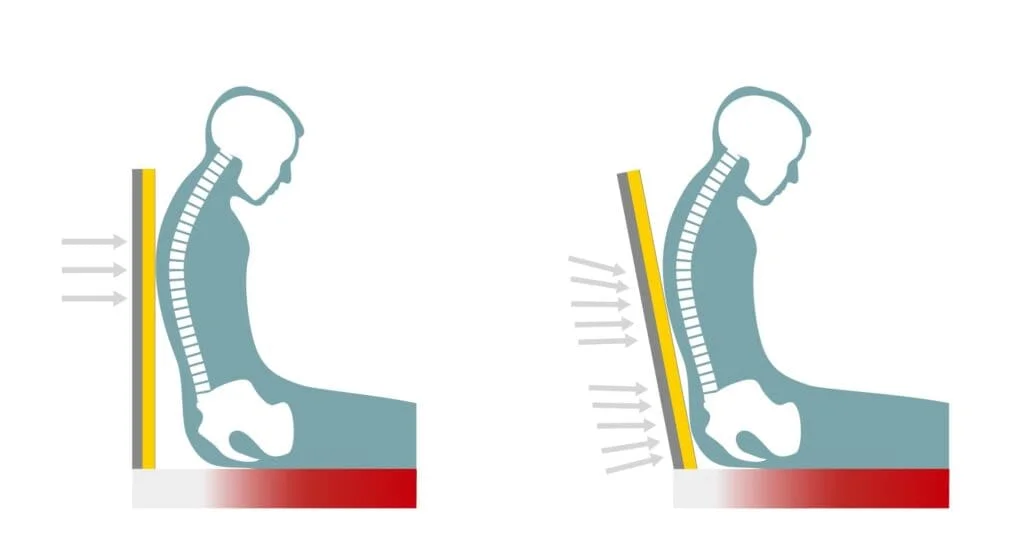
Fig. 1. Fig. 2.
If a wheelchair user with kyphosis wants to limit the contact area for pressure sores to occur, they will probably end up compromising a comfortable seating position. They will end up not sitting with their hips positioned all the way to the backrest (Fig. 1). In saying that, if the user does sit with their hips against the backrest (Fig. 2), they increase the contact areas which exposes them to more areas where pressure sores can occur.
The solution is to choose a manual wheelchair with a tension adjustable backrest that can be adjusted to evenly distribute the pressure on the backrest (Fig. 3). Thus, reducing the chance of getting pressure ulcers.
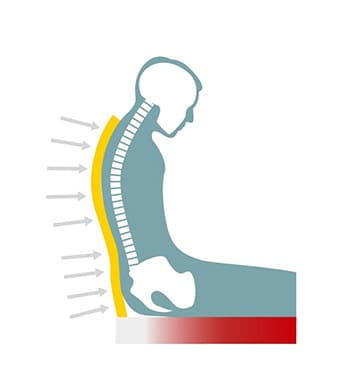
Fig. 3.

Flexx wheelchair is overall, a highly adjustable wheelchair. For example, the backrest has discrete velcro straps that can be used to accommodate a wheelchair user with kyphosis.
Positioning wheelchairs
A positioning wheelchair is the ideal choice for users who can’t walk, sit independently, and/ or have poor neck control. A positioning chair is also ideal for elderly user’s with elderly caregivers, as it takes little effort to reposition the user to distribute their weight.
Tilting the wheelchair reduces the pressure on the hips by shifting the centre of gravity from the hips to the back. Tilting the wheelchair prevents the user from sliding down the seat and risking skin damage. The tilting function allows the user to rest in the wheelchair without having to be moved to a bed. For every hour that an elderly wheelchair is sitting in the wheelchair, we recommend that they are repositioned in the tilted position for 20 minutes.
Reclining the wheelchair will allow the user to lie down and stretch out their hips and lower back. However, when the user returns to the upright position, they might slide forward which in turn will cause them to experience shear force. Occasionally they may also find that the headrest doesn’t align correctly so they need to use a pelvic belt.
A better wheelchair, a better fit
At KARMA, we understand that there is no best wheelchair, only the best fitted wheelchair for each user. Therefore, you should choose a wheelchair that meets the user’s needs to prevent pressure sores, whether it’s a positioning wheelchair or additional wheelchair accessories.
Keep Reading
The post Wheelchair Accessories That Can Prevent Pressure Ulcers first appeared on KARMA Medical.]]>Myth 1 – Elevating the leg rests will stop the user from sliding
At first, this may be true; however, if an elderly user hasn’t stretched their hamstrings in a long time, they will be tight, so stretching them will be uncomfortable and maybe even painful. Therefore, the user will resume sliding.
A better solution would be to invest in a wheelchair that can elevate the leg rests as well as recline. The reclining function shifts the weight from the user’s pelvis, across the user’s whole back. The shift of the user’s center of gravity is what will stop the user from sliding.
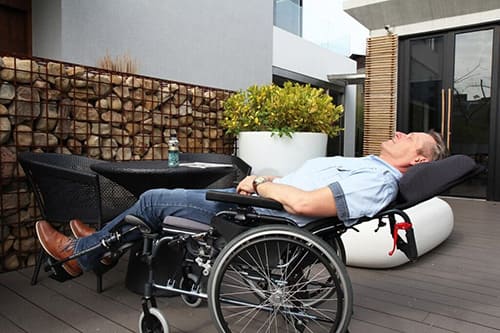
A reclining wheelchair will prevent the user from sliding down the wheelchair. Source: Karma MVP 502 reclining wheelchair.
Myth 2 – Elevating the leg rests will reduce swelling (edema)
Maybe at first, however, the height of the footrest, although elevated, is still much lower than the user’s heart. If the elderly user needs a wheelchair to reduce swelling, then a wheelchair with other features such as reclining and tilting is required.
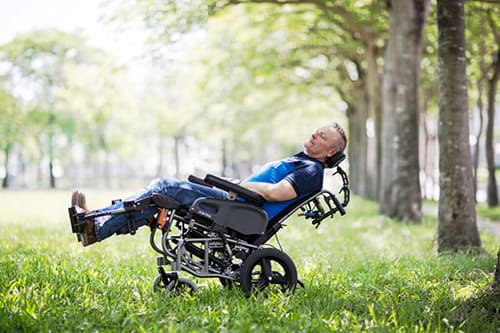
In order to reduce swelling, the user’s legs need to be above the height of the user’s heart. Source: Karma VIP 2 Titling and Reclining Wheelchair.
Myth 3 – Elevating leg rests reduce the pressure on the buttocks
Lifting the legs will reduce the contact area between the thigh and seat cushion, so the pelvis is more likely to slide forward, so there is more pressure on the spine. If the goal is to reduce the likelihood of pressure sores, then a wheelchair with both reclining and tilting features is necessary. Karma’s VIP2 can recline, Tilt-in-Space, and even fold to fit in the trunk of a car.
What is the correct wheelchair leg rest position?
The leg rests should be in a comfortable position where the feet can reach the footrests. When elevating the legs, it should be done in increments so as not to overstretch the elderly user’s hamstrings. The best solution is to invest in a tilting and reclining wheelchair so that the user can reap the benefits of hassle-free repositioning.

Elevating the leg rests should be comfortable for the user and not cause them any pain. Source: Karma Medical YouTube – MVP502 Reclining Wheelchair / VIP515 Tilting Wheelchair
Keep Reading
The post Busting Myths about the Leg Rests on a Wheelchair first appeared on KARMA Medical.]]>Opt for a positioning wheelchair that is specially designed to prevent skin damage to the user. Using the recline or Tilt-in-Space functions changes the user’s posture and center of gravity to relieve the constant pressure felt on certain parts of the body.
1. Reclining Wheelchair
The reclining wheelchair will transform the user from a sitting position to a close to lying down position. The change of position reduces pressure on the buttocks and allows the user to take a break from sitting in the same position.
Unfortunately, “sliding” is a common problem with reclining wheelchairs. Whenever the wheelchair reclines or returns to an upright position, the user’s back will naturally slide against the back of the wheelchair, creating uncomfortable frictions and may lead to skin breakdown.
One of the best selling reclining wheelchairs is Karma MVP 502. Its innovative anti-sliding design slopes downwards 20 degrees, which helps reduce the forward sliding and pressure sores. This significantly reduces shearing on the user’s back and reduces the need for the attendant to reposition the user.
2. Tilt-in-Space Wheelchair
The biggest difference between a tilting and reclining wheelchair is that the reclining wheelchair will change the posture of the body. If the user can NOT sit up straight independently, they might slide out of the chair or lean to one side when lying down.
The Tilt-in-Space wheelchair doesn’t change the angle of the user’s body. Only the seat is tilted backward. By shifting the pressure away from the hips onto a larger surface area, the caregiver does not need to constantly readjust the user into the seated position. This also helps the user to reduce the risk of developing bedsores and avoid back pain.
One of the most popular Tilt-in-Space wheelchairs on the market is Karma VIP 515. VIP 515 is one of the only foldable Tilt-in-Space wheelchairs on the market. This means that elderly wheelchair user’s who need this function when they are out and about can enjoy comfort and stability. The increased frequency of being able to change position will decrease the chance of pressure building on in one area and causing pressure sores.
Using these positioning functions will help shield the user from the threat of pressure ulcers and bedsores. Using a manual or power wheelchair to change the user’s position to provide relief, can also improve the user’s comfort, ability to relax, and improve their overall health.
A combination of both of these features; reclining and tilting, give the user the option of more positions to change to. A combination of these features also makes life for carers easier as they can spend less time and effort adjusting the user’s sitting position.
Featured Products
Keep Reading
The post The Benefits of a Reclining and Tilting Wheelchair first appeared on KARMA Medical.]]>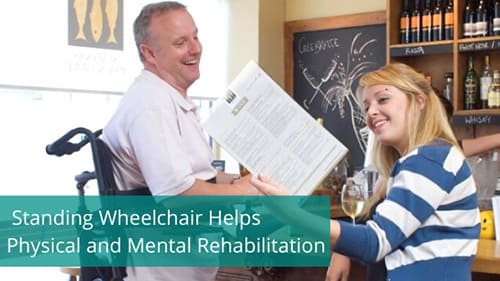
Standing helps the user physically and mentally. We know and understand these benefits from a physical therapy point of view as well as users sharing their stories with us! The benefits of standing to the mind and body will be illustrated further:
A Karma user once shared with us that they have been using a standing wheelchair for the past 7 years, and the “standing” feature was what he felt, the most important part of his rehabilitation. If he didn’t get out of bed and stand up, his whole body felt wrong. After using the standing feature long-term, his dizziness and stomach discomfort gradually improved.
1. Physical Benefits from Standing
In addition to reducing the occurrence of pressure sores on the buttocks and reducing the stiffness of the muscles and lower limb joints, standing’s biggest benefit is that it slows down osteoporosis.
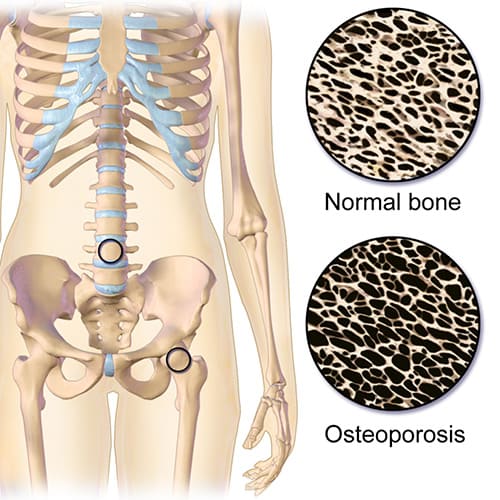
Standing wheelchair’s biggest benefit is that it slows down osteoporosis.
When the user sits and lays down every day for too long, the bones stop bearing any weight which worsens the bone density. Even if the user takes calcium supplements, they may wonder why they are still at risk of osteoporosis. The main reason is that..in order for the body to absorb calcium the bones need to be stimulated . This is why doctors say that exercise is the only way to slow down osteoporosis.
Therefore, using standing aids help to stimulate the increase of bone density, slow down the rate of bone loss, and gradually make your body healthier.
2. Standing Helps the User’s Life and Mind
Standing wheelchairs improve life function
Being able to stand up compensates for the height difference from the sitting position. It allows the user to reach things such as objects on shelves or bookcases, improving the user’s sense of independence and making work more efficient. These are all benefits that standing can bring.
Standing wheelchairs increase self-confidence
Wheelchair users often have some disadvantages during peer to peer interactions because of the height difference from the sitting position. Standing allows the wheelchair user to talk with people with the same level of eye contact. Interacting with people at the same eye level can eliminate the barrier or socialization and interpersonal relationships that wheelchair users usually have.
3. Am I Eligible for Standing Rehabilitation?
After reading about all the benefits of a standing wheelchair you must want to try the standing wheelchair for yourself. So, what is the first step?
Think about your day to day life:
- When you wake up in the morning and go to get on your wheelchair, do you transfer to the wheelchair on your own or do you need help from others?
- How many times do you go out in a month?
Knowing more about a user’s lifestyle can determine whether or not their bones and joints are able to bear any weight as well as if there will be a chance of osteoporosis. So, if you are bedridden, does that mean you are not suitable for standing rehabilitation?

Even with a severe disability, there is always a need to stand. Sometimes it requires the help of professional assessments and step by step practice to reach the level of being able to stand. Before anyone uses a standing assistive device, you must first go through the assessment of a therapist and train according to the method set out by the therapist to avoid secondary injury.
Summary
On average, an able-bodied person stands and walks up to 3 hours a day, about ⅛ of their day. Standing is a very important daily activity! We hope that by reading this blog post that you will be encouraged to try standing rehabilitation, continue to improve your physical condition, and make your lives more independent!
You can contact your local dealer to find out more about a Standing Wheelchair or other power wheelchairs.
Keep Reading
In the last blog, FAQ when buying a wheelchair, we discussed the different levels of mobility and what wheelchair is most suitable within each category. Now we will move on to discuss the benefits and wide range of positioning wheelchairs.
How Does a Reclining Wheelchair Work?
The reclining wheelchair seat works like a car driving seat. As well as sitting upright in a reclining wheelchair, the user can lie flat at almost 180 degrees. The knees can also be raised up to help the user stretch out their hips and lower back. To put it simply, it can extend from a wheelchair to a resting platform, almost like a bed.
Reclining wheelchairs are suitable for users who need to use a wheelchair for long periods of time, thus requiring some posture change to relieve the sitting pressure. When the user goes into the reclining position, their centre of gravity shifts from the pelvis to the back. This is also why the rear wheels are set further back, behind the user’s centre of gravity. Therefore it is not suitable for the user to self propel the wheelchair themselves.
The common pitfall of choosing a reclining wheelchair is to neglect the user’s ability to resist the tendency of sliding out. The motion of the recline will create forces on the skin surface.
How Does a Tilting Wheelchair Work?
The “Tilt-in-Space” wheelchair is designed to keep the user in the sitting position, where the angle of the hip joints is unchanged. Instead, the pressure on the hips is transferred to the back.
How does a reclining and tilting wheelchair benefit elderly users with limited joint movement?
-
There is no change or movement of the joints when tilting, so it is suitable for elderly patients who have stiff joints.
-
Unlike the reclining wheelchair, the ‘Tilt-in-Space’ feature ensures the user will remain close to the seat whilst the chair is tilting to avoid any shear force.
-
By tilting the chair, the caregiver can help the wheelchair user shift the pressure from the hipbone to the back, preventing the body from forming pressure ulcers (bed sores) as well as sliding down.
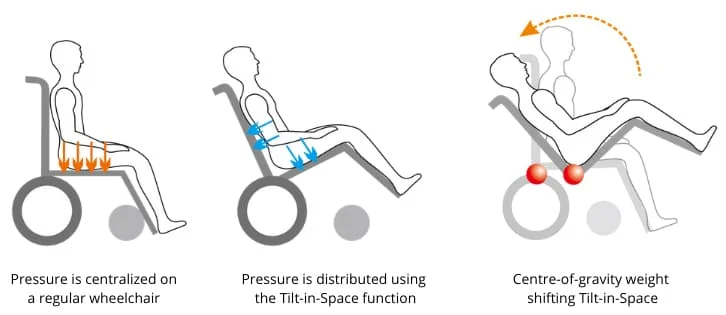
When using a general wheelchair, the pressure is concentrated under the hips (left). When the user is “Tilted-in-Space”, the pressure is evenly distributed to the back and buttocks (middle). The center of gravity shifts when the user is “Tilted-in-Space” (right). Source: Karma Medical
Reclining vs Tilting Wheelchair
When the user’s physical condition is weaker, we would recommend a Tilt and Recline combined wheelchair to reduce sitting pressure on the hips and provide more flexibility to support the hip-joint angle.
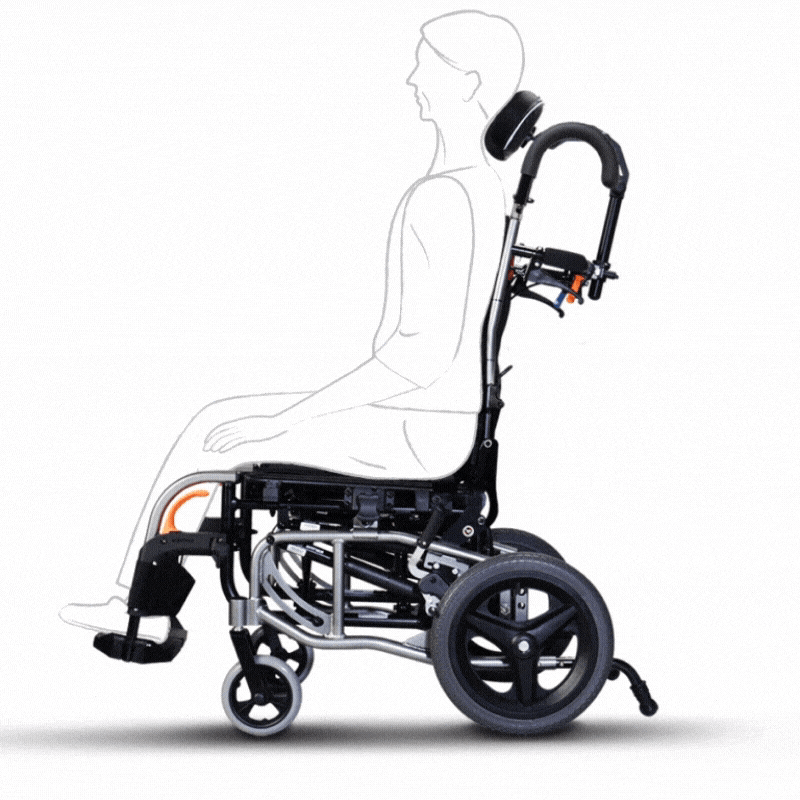
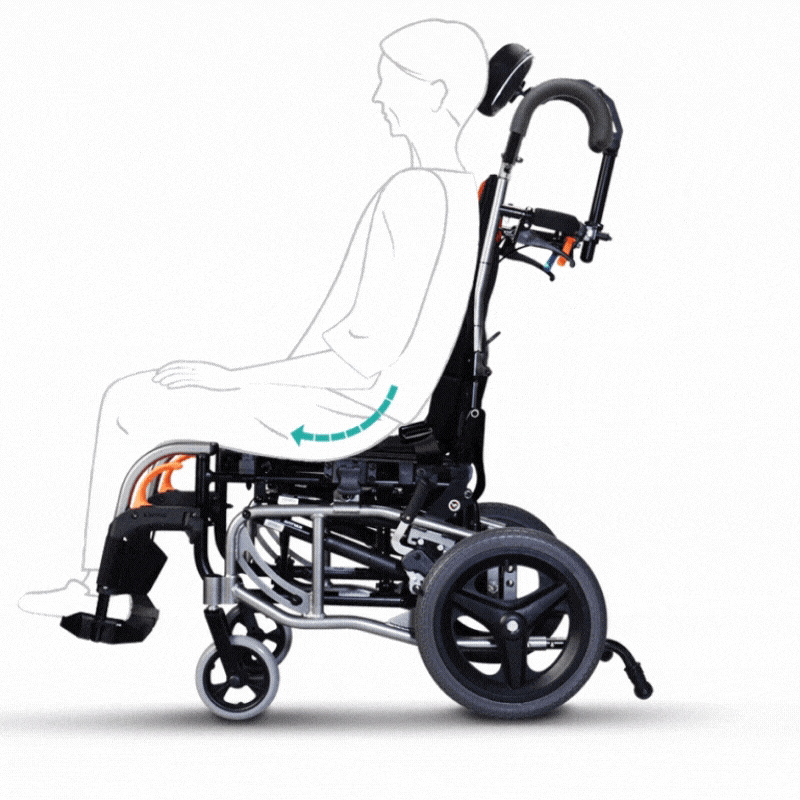
VIP2 is the 2-in-1 wheelchair with the ability to recline as well as Tit-in-Space. Source: VIP2
Which Wheelchair Wheels are Best?
If the user often goes outdoors and needs to cross large thresholds, then large wheels will save the carer a lot of effort. If the wheelchair is mainly used indoors, smaller wheels are lighter, the storage size is smaller, and it has less chances to interfere with transferring to and from the wheelchair.
Summary
We would hope that instead of using straps or restraints to keep the elderly in the wheelchair, more nursing homes can leverage the benefits of Reclining and “Tilt-in-Space” wheelchairs, so the long-term care can be easier for everyone.
Contact us or your local dealer to try out a reclining and tilting wheelchair!
Keep Reading


